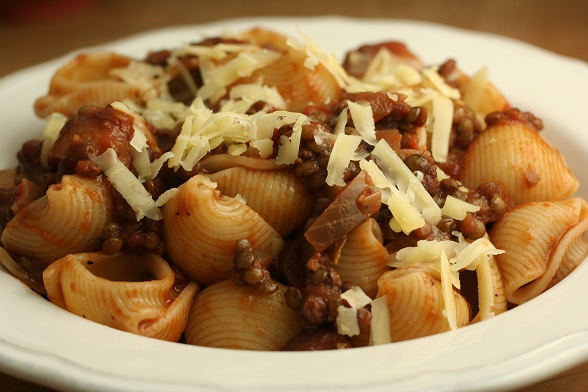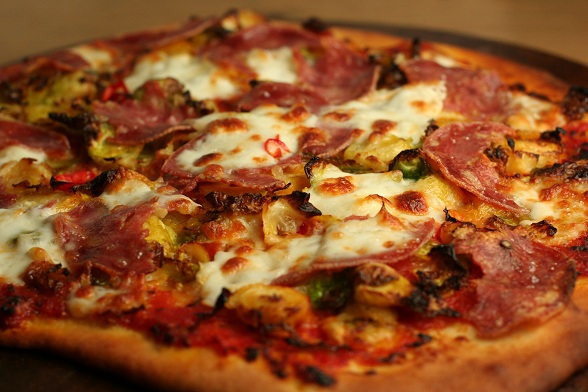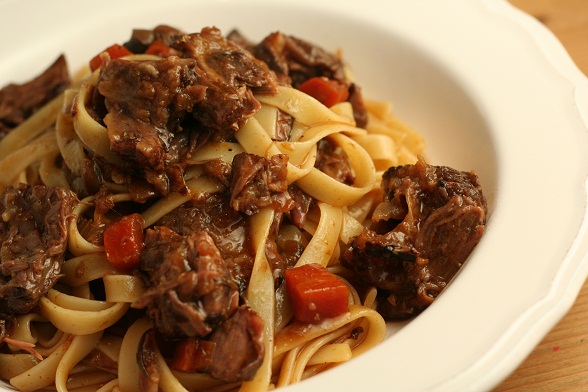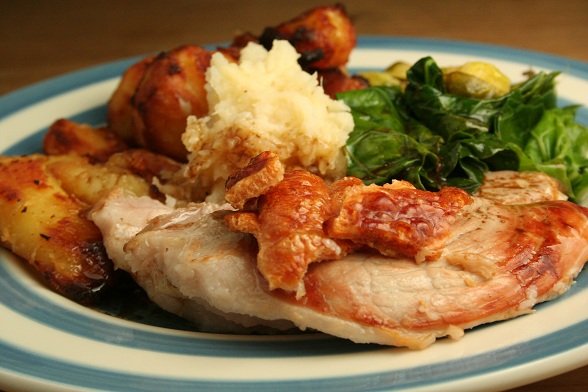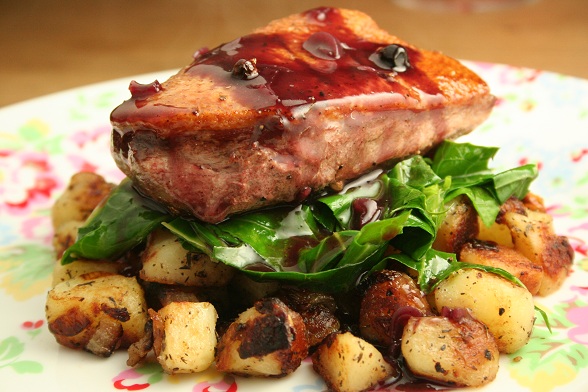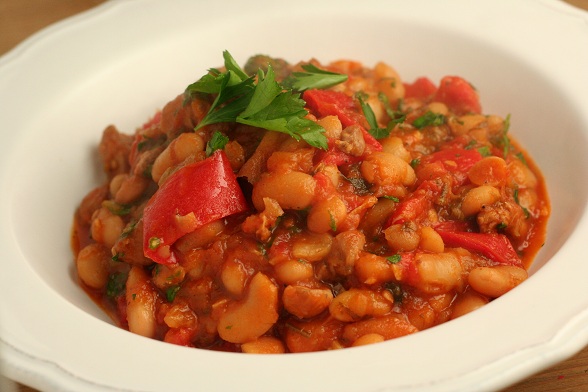Lentil and Bacon Ragu
I wrote this up at the time of eating but forgot to post it and have just found it in the draft folder. Lucky for me since I wouldn’t have remembered any of this.
Both Stephen and I are recovering from heavy colds and today’s weather meant we didn’t feel much like venturing from the house. At this time of year, there’s not a lot in the fridge as there’s so much going on in the evenings that we’re not finding much time to cook. There are always lentils in the cupboard though and always some kind of bacon in the freezer so this was easy to put together while we snuffled and sneezed our way through the day.
Not the most exciting dish for a Saturday night but it was easy to cook and since neither of us have much of an appetite anyway, it’s relative simplicity was soothing and comforting. I ate mine with pasta, Stephen had his with bread.
Lentil and Bacon Ragu
Serves Two
250g bacon
1 onion, finely chopped
2 cloves garlic, crushed
Bay leaf
Large handful herbs, finely chopped (I used fresh thyme and rosemary)
Tablespoon tomato puree
200g puy lentils
Salt and pepper
Nutmeg
Glass red wine
300ml vegetable stock
Worcester sauce
1 tin tomatoes
Start by frying the bacon until the fat has rendered. Remove to a plate.
In the same pan, add some olive oil and then soften onion and garlic. Next add the bay leaf and the herbs and cook briefly before stirring in the tomato puree. Ensure everything is coated and then cook for a couple of minutes.
Now add the lentils and give everything a good stir. Season and grate in the nutmeg. Deglaze the pan with the red wine and allow the alcohol to cook out. Add the rest of the ingredients, bring to the boil and then simmer for around 40 minutes.



Brussels Sprout Pizza
I know, it sounds a bit novelty doesn’t it? Like I was trying to come up with a festive pizza or something. I wasn’t (although it’s got me thinking) but was instead wondering whether it would be as good as our favourite pizza of the year: the cavolo nero pizza. It wasn’t as good but we both enjoyed it anyway.
The Brussels sprouts (which had been previously sauteed in olive oil and butter) weren’t as deep and earthy as the cavolo nero but they did have a bitter edge that added an interesting flavour to the pizza. The salami balanced that bitterness nicely, as did the sweet tomato sauce.



Oxtail Ragu with Tagliatelle
Oxtail is something I normally think of as being accompanied by mashed potatoes but I’ve seen various references to it online as being served with “egg noodles”. I’m a big fan of pasta so was keen to give it a go and put together a recipe I thought would befit some glossy tagliatelle (papardelle was my first choice but I didn’t have any).
The ragu was similar to the hundreds of other ragus I’ve made before: a base of onions, garlic, celery and carrot, meat browned separately and with lots of herbs and wine added but somehow, it tasted more like a casserole than a ragu.
Not that it was bad, it was actually really good, it just would have been better with mashed potatoes instead of pasta.
Oxtail Ragu
Oxtail (I had four large pieces)
Salt and Pepper
1 large onion, finely chopped
2 carrots, finely chopped
2 stalks celery, finely chopped
3 cloves garlic
Bay leaf
Herbs (I used thyme and rosemary)
1 tbsp tomato puree
Large glass red wine
Splash worcester sauce
Start by browning the seasoned oxtail. Remove to a plate and blot the excess oil with kitchen paper.
In the same pan, soften the onions, carrot, celery and garlic. Add the herbs and allow to cook for another couple of minutes. Next add the tomato puree and stir so everything is well coated. Return the meat to the pan and add the wine. Allow the wine to bubble and cook for about two minutes or until the alcohol has burnt off.
Finally, add the worcester sauce and season. Bring to the boil, reduce the heat and then simmer for three-four hours. Keep an eye on the water level and top up if necessary.
Serve with mashed potatoes 🙂



Pork Chops with Whisky, Mustard and Mushroom Sauce
While this clearly doesn’t look particularly appetising, it was actually really good. We cooked it the first time at my mum’s house but the pictures didn’t come out very well. One could argue that this picture didn’t come out particularly well either and I wouldn’t disagree but I’ve temporarily suspended my quest for a decent picture and am posting it anyway.
The sauce is obviously what makes this so interesting and it was very simple. Make it while you’re frying the chops and mashing the potatoes and the whole thing will take about 25 minutes.
Whisky, Mustard and Mushroom Sauce
5 shallots, finely chopped
200g chestnut mushrooms, finely chopped
Salt and pepper
50ml whisky
2 tsps wholegrain mustard
150ml cream
Start by softening the shallots until they just begin to colour. Add the mushrooms, season with pepper and cook until any liquid from the mushrooms has evaporated. Pour in the whisky, cook until it has almost evaporated, add the mustard, the cream and season.



Leftover Pork Wraps with Refried Beans
This is something we often cook on a Monday if we’re fortunate enough to have leftovers from the day before. We often do have leftovers because we generally buy a larger piece of meat than we need – it makes for a quick and easy meal on a Monday night and I think the larger the joint of meat, the less chance there is of it drying out on the day of roasting.
There’s a few posts on this particularly leftover dish so I won’t go into much detail (you can find the method for the chilli sauce that the pork is reheated in here) but we have altered our bean recipe so I wanted to record that.
We’ve been making these beans for a while and really like them, the original recipe is a real faff though so we’ve been playing with it to see if we can simplify it without losing any of the flavour. This is much simpler and is a really versatile recipe that works well in wraps or as an accompaniment to other Mexican dishes. It freezes well too.
Mexican Beans
Serves Two
175g dried beans, preferably black (turtle) or pinto beans
1 onion, finely chopped
3 garlic cloves, chopped
1 bay leaf
2 red chillies, cored, deseeded and chopped
1/2 tbsp vegetable oil
Small tin chopped tomatoes
Salt
Put the beans into a pot, add cold water to cover.
Add half the chopped onion, half the garlic, the bay leaf and the chillies. Bring to the boil, reduce the heat, cover and cook until the beans are tender. The cooking time will vary depending on the beans and whether you’ve soaked them or not. Allow two hours but check regularly and top up with water if necessary. You want the water to have almost completely evaporated by the time you’ve finished this stage but you can drain the beans if you need to. I usually do this the night before I need the beans and refrigerate them at this stage, completing the next step on the following day.
About 20-30 minutes before the beans are cooked, heat some oil in a frying pan and soften the remaining onion and garlic. Add the tinned tomatoes and cook for about five minutes. Add a quarter of the cooked (and drained) beans into the frying pan and mash. Stir in the remaining beans, mix, season with salt and then serve.



Roast Pork
Is there a patron saint of cooking? I’m not sure and Google was inconclusive. If there is such a thing and indeed, if I believed in such things, then I imagine she (it’s got to be a she, right?) was looking down on us this weekend. After not spending much time in the kitchen recently, we managed to produce the third really good meal in as many days. I don’t think we did anything drastically differently today and yes, I know roast pork isn’t all that difficult but for whatever reason, everything seemed to work brilliantly this time.
The meat (from Waitrose) had lots of flavour and remained juicy with super-crackly crackling. Having said I didn’t do anything differently, I did remember to cook the meat on the highest setting for the first 30 minutes before turning the oven down to 180 degrees which I don’t always remember to do. The potatoes and parsnips were crisp with lots of crunchy edges and fluffy insides (vegetable oil only today instead of a combination of vegetable and olive) and the vegetables were fresh and just interesting enough to compliment the meat without taking over (a dash of fennel seeds in the garlicky greens helped this). Oh, and that’s mashed celeriac in the middle which was wonderfully creamy and smooth.
I had planned to make stuffing but forgot so I guess that patron saint might have got distracted but otherwise, a glorious end to a brilliant weekend.



Ox Cheek Daube
Beef daube is not something I’ve eaten or cooked before so when a friend mentioned she was cooking it this weekend, I started looking at recipes. I was looking for something that would sit happily in the oven all afternoon while we decorated the tree and this was perfect. Like all slow-roast or braised dishes, there’s a little work upfront and then all you need is patience while you wait for the end result (or, in our case, sustenance in the form of mince pies).
I looked at three or four different recipes which varied rather a lot so I just took the parts I liked best from each and combined them. I didn’t have time to let the meat sit in the wine for three days so skipped that but was keen on the combination of red wine and brandy so kept that element. The addition of orange is not something I would have thought of but really helped to cut through the richness of the wine and the brandy and added a festive note too which was fitting.
Olives appeared in all the recipes I read and I would have added them if we had any but I’m glad I didn’t. I can’t imagine how the texture would have worked but I think I would have liked the flavour.
We used ox cheeks because I happened to spot some in Waitrose but the recipes I found online also used beef shin or braising steak. We both really enjoyed this and ended up eating far too much. I’m happy with the combination of flavours we used but felt the orange was just a little too strong and would reduce the zest a little next time.
Ox Cheek Daube
Serves Two, generously
700g beef
Salt and pepper
Flour
Oil
1 large onion, sliced
2 sticks celery, chopped
4 cloves garlic
4 stems thyme
2 bay leaves
1 tsp fennel seeds
4 anchovies
1 tbsp tomato puree
500ml bottle red wine
2 tbsps brandy
300ml beef stock
Zest of one orange, finely chopped
Juice of half an orange
Start by chopping up the beef and tossing in the seasoned flour. Brown the meat in batches and then remove from the pan and blot away the excess oil with some kitchen paper.
In the same pan, add more oil if necessary and then soften the onion, celery and garlic with the thyme, fennel seeds and the bay leaves for about 10 minutes. You want the onions to take on a little colour but not so much that they start to caramelise. Add the anchovies and tomato puree and cook until the anchovies melt.
Return the meat to the pan and then add the wine and the brandy. Let this bubble away until the volume has reduced by half. Now add the beef stock, the orange zest and the juice and bring to the boil. Once everything is boiling, transfer to the oven for three hours.



Mince Pies
One of my favourite things about Christmas are the traditions that go alongside the presents and the turkey. I like a big tree with too-many decorations on it (I get this from my mum, her tree is so overloaded that you can’t really see the branches and it often falls over), I like strings of fairy-lights covering every available surface and I like decorating the house while listening to Christmas music and eating mince pies. We did that yesterday and baked the first batch of mince pies from the mincemeat we made a couple of weeks ago. We used the same recipe we use every year but this time, the spicing was a little light and there was too much apple coming through. Easy enough to rectify though and a good job we checked in advance of the big day.
Hettie Potter’s suet-free Mincemeat
Makes about 2kg
250g soft dark sugar
250ml medium dry cider
1 kg cooking apples, peeled, halved and quartered
1/2 tsp mixed spice
1/2 tsp ground cinnamon
250g currants
250g raisins
75g glace cherries, roughly chopped
75g blanched almonds, finely chopped
rind and juice of 1/2 lemon
6 tbsp brandy or rum
In large saucepan, dissolve the sugar in the cider over a gentle heat. Add the roughly chopped apples to the saucepan. Add all the ingredients, apart from brandy/rum and simmer for around 30 min until everything has a pulpy consistency. Take off the heat and when it has cooled slightly stir in brandy/rum.



Duck Breast with the Best Sautéed Potatoes
We have had a couple of memorable successes with duck breasts before, particularly with rösti, but recent rösti attempts have been less successful so we decided on sautéed potatoes to accompany these instead. Armed with a large bag of potatotes and the last two duck breasts from the shelf in Waitrose, we set about preparing. We served it with a redcurrant and red wine sauce and some sautéed greens of the sort that we ate for seven days in a row a few weeks back.
It turned out very well indeed. The duck breast was cooked pinkish, just how we wanted it to be, the sauce had (almost) just the right amount of everything in it and the potatoes turned out to be the best ever. The potatoes were the big revelation from this meal; we have cooked them many times and I think it was the addition of garlic this time round that made a big difference. Along with letting them crisp up slowly while the sauce and duck cooked.
Duck breasts
Ingredients:
2 duck breasts
salt and pepper
Method:
Score the skin side a few times, this will allow the fat to cook out more easily. Heat a frying pan on medium heat and put the duck breasts in skin side down. Cook for about ten minutes; the fat will render out from under the skin and should leave the skin nice and crispy and you’ll end up with lots of fat in the pan. Then turn them over and cook for another five. Remove and let them rest.
Redcurrant and Juniper Sauce
Ingredients:
3 shallots, finely chopped
glass of red wine
half glass of chicken stock
tablespoon of redcurrant jelly
sprig of thyme
bay leaf
5 juniper berries
salt and pepper
red wine vinegar (1/2 tsp or so)
1 tsp cornflour
Method:
Pour the red wine into a small saucepan along with the stock, thyme, bay, juniper and redcurrant jelly. Bring to the boil and lower the heat to a simmer and leave it for another ten minutes. Taste and add salt, pepper and vinegar to taste as you see fit. Mix the cornflour with a dash of water and then add it to the sauce to thicken it, stirring all the time.
Sautéed Potatoes
Ingredients:
Potatoes (preferably a fairly waxy variety; we used Désirée)
Half a medium to large onion, finely chopped
1 clove of garlic
1 tsp dried thyme
salt and pepper
olive oil
Method:
Slice the potatoes and boil or steam until almost cooked. Slice into 1cm cubes. While this is happening, heat the olive oil in a large frying pan over low to medium heat. Add the onion and allow to soften for five minutes. Add the garlic and cook for another 5 minutes. Just allow these to soften, not brown – there will be plenty of opportunity for that later! Then add the cubed potatoes, with a little extra oil if it looks like it needs it. Season liberally with salt and pepper and thyme. Cook on a low heat for 20 to 30 minutes, shaking the pan and turning the potatoes frequently to allow them to brown on all sides. Taste for seasoning and add more salt, pepper or herbs as you see fit.



Chicken and Cannellini Beans
While I get on with clearing the backlog, here’s a quick and easy dish you can throw together in no time. I cooked this on Monday night while waiting for something from the freezer to heat up. It went into the fridge overnight and just needed heating up the next day. You could eat it the same day but the flavour is better if left overnight. Some chorizo would have been really good in here but I didn’t have any so just increased the paprika, Not quite the same but close enough in an emergency.
Chicken and Cannellini Beans
Serves Two
250g cannellini beans
4 chicken thighs
Olive oil
Salt and pepper
1 large onion, roughly chopped
Parsley stalks, chopped
1 red pepper, sliced
2 cloves garlic, crushed
Sprig thyme
2 bay leaves
2 tsps paprika
1 tbsp tomato puree
Large glass white wine
250ml chicken stock
Tin chopped tomatoes
If you’re using dried beans then start these straight away and cook according to the instructions on the packet. These will take much longer to cook than the rest of the dish so if you don’t have any already cooked but don’t want to use tinned beans then you can just add these to the finished dish – either after the final 30 minutes cooking time or when you reheat it the next day.
Start by browning the seasoned chicken thighs in olive oil and then removing to a plate. Blot with kitchen paper to remove the excess oil.
Using the same pan, soften the onions, some parsley stalks and the pepper for about eight minutes. Then add the garlic, thyme and bay leaves and cook for another two minutes. Next add the paprika and stir to incorporate.
Add a good squeeze of tomato puree and stir again so that everything is coated. Cook for a couple of minutes before adding the wine. Let this bubble away until the alcohol has cooked out and then return the chicken to the pan along with the chicken stock, tomatoes and cooked beans.
Bring to the boil, reduce the heat and cook for 30 minutes. Stir the parsley through before serving.



